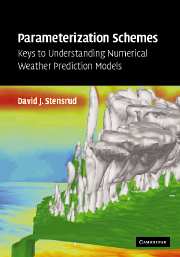Book contents
- Frontmatter
- Contents
- Preface
- List of principal symbols and abbreviations
- 1 Why study parameterization schemes?
- 2 Land surface–atmosphere parameterizations
- 3 Soil–vegetation–atmosphere parameterizations
- 4 Water–atmosphere parameterizations
- 5 Planetary boundary layer and turbulence parameterizations
- 6 Convective parameterizations
- 7 Microphysics parameterizations
- 8 Radiation parameterizations
- 9 Cloud cover and cloudy-sky radiation parameterizations
- 10 Orographic drag parameterizations
- 11 Thoughts on the future
- References
- Index
4 - Water–atmosphere parameterizations
Published online by Cambridge University Press: 05 September 2013
- Frontmatter
- Contents
- Preface
- List of principal symbols and abbreviations
- 1 Why study parameterization schemes?
- 2 Land surface–atmosphere parameterizations
- 3 Soil–vegetation–atmosphere parameterizations
- 4 Water–atmosphere parameterizations
- 5 Planetary boundary layer and turbulence parameterizations
- 6 Convective parameterizations
- 7 Microphysics parameterizations
- 8 Radiation parameterizations
- 9 Cloud cover and cloudy-sky radiation parameterizations
- 10 Orographic drag parameterizations
- 11 Thoughts on the future
- References
- Index
Summary
Introduction
Pictures of the Earth from space often show a small blue and white ball on a black background. While we often think of the Earth as being green in color, in reality most of our planet's surface has a bluish color owing to the prevalence of the oceans. Oceans cover 70% of the Earth's surface, with an average depth of nearly 4 km, and as a major component in the global hydrological cycle liquid water is an essential resource for the survival of all animals and plants. It is perhaps not surprising to learn that to predict the Earth's climate, or to provide an accurate weather forecast, one must understand how the atmosphere and the ocean interact, and be able to represent these processes in numerical weather prediction models.
Air–sea interactions occur across a wide range of spatial and temporal scales. The ocean influences the atmosphere predominantly through variations in sea surface temperature (SST) and its effects on surface fluxes into the atmosphere, while the atmosphere influences the ocean predominantly through variations in the stress exerted upon the ocean surface by low-level winds. However, the interactions occurring on any given day are often much more complicated.
Surface fluxes of sensible and latent heat from the ocean surface to the atmosphere can play a significant role in the development and evolution of large-scale atmospheric disturbances such as extratropical cyclones, tropical cyclones, and polar lows.
- Type
- Chapter
- Information
- Parameterization SchemesKeys to Understanding Numerical Weather Prediction Models, pp. 120 - 137Publisher: Cambridge University PressPrint publication year: 2007

